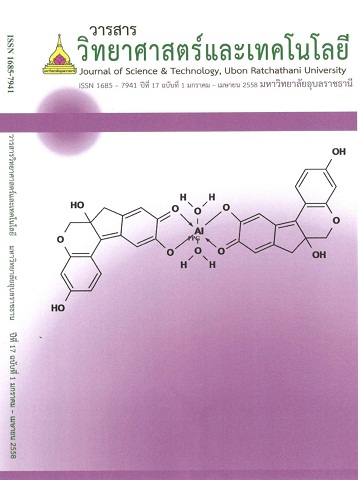Investigation of Butyrate-producing Bacteria and Genes from Fecal Samples of Thai Volunteers
Main Article Content
บทคัดย่อ
Butyrate, produced by intestinal anaerobic bacteria via dietary carbohydrate fermentation, is an important energy source for gut epithelial cells. The butyrate also plays a crucial role in homeostasis of intestinal epithelial cells including cellular proliferation, differentiation, and apoptosis. Butyrate production depends on the type of diet and availability of butyrate-producing bacteria. Bacteria of Clostridial cluster IV (CIV) and cluster XIVa (CXIVa) are major butyrate producers. This study investigated: i) the availability of Faecalibacterium prausnitzii (a representative of CIV) and Clostridium coccoides–Eubacterium rectale group (a representative of CXIVa), and ii) the presence of the butyrate-producing genes, butyryl-CoA: acetate CoA-transferase (but) and butyrate kinase (buk), in fecal samples of butyrate-producing volunteers using quantitative PCR. The samples were obtained from six normal (BMI23) and eight overweight (BMI23) Thai volunteers. The results showed the trend toward higher levels of Faecalibacterium prausnitzii found in the overweight volunteers as compared to the normal-weight volunteers. However, the proportion of Clostridium coccoides–Eubacterium rectale was not different between the two groups. Interestingly, the availability of Faecalibacterium prausnitzii showed significant positive correlation to the presence of but (r=0.752, p<0.05) and the BMI was positively correlated to the presence of buk (r=0.812, p<0.01).
สารบิวทีเรท (Butyrate) ในลำไส้เกิดขึ้นจากการหมักอาหารจาพวกคาร์โบไฮเดรต โดยแบคทีเรียซึ่งอาศัยอยู่ในลำไส้ บิวทีเรทเป็นแหล่งพลังงานที่สำคัญสาหรับเซลล์เยื่อบุผิวลาไส้ นอกจากนี้ยังมีบทบาทสำคัญในการรักษาสมดุลของเซลล์เยื่อบุผิวลำไส้ ได้แก่ ควบคุมการเพิ่มปริมาณ การเปลี่ยนสภาพและการตายของเซลล์เยื่อบุผิวลำไส้ ปริมาณบิวทีเรทที่ผลิตได้ขึ้นอยู่กับหลายปัจจัยเช่น ชนิดของอาหารที่รับประทาน ปริมาณของแบคทีเรียกลุ่มที่ผลิตบิวทีเรท การศึกษาก่อนหน้านี้พบว่า มีแบคทีเรียที่ผลิตบิวทีเรทสองกลุ่มคือ แบคทีเรียคลอสติเดียลกลุ่มที่สี่ (CIV) และแบคทีเรียคลอสติเดียลกลุ่มสิบสี่เอ (CXIVa) วัตถุประสงค์ของการศึกษาครั้งนี้คือ หาปริมาณของแบคทีเรีย Faecalibacterium prausnitzii (ตัวแทนของ CIV) และปริมาณของ Clostridium coccoides-Eubacterium rectale (ตัวแทนของ CXIVa) และ วัดปริมาณของยีนที่ควบคุมการผลิตบิวทีเรทซึ่งได้แก่ยีน butyryl-CoA: acetate CoA-transferase (but) และยีน butyrate kinase (buk) ในตัวอย่างอุจจาระของอาสาสมัครจำนวน 14 คน ด้วยวิธี quantitative PCR ในการศึกษานี้แบ่งตัวอย่างอุจจาระของอาสาสมัครออกเป็นสองกลุ่มตามดัชนีมวลกาย กลุ่มแรกมีดัชนีมวลกายปกติ (BMI≤๒๓) จำนวน 6 คน และกลุ่มที่สองมีดัชนีมวลกายเกิน (BMI> 23) จำนวน 8 คน ผลการศึกษาพบว่า สัดส่วนปริมาณแบคทีเรีย Faecalibacterium prausnitzii ในอุจาระของอาสาสมัครที่มีดัชนีมวลกายเกินปกติมีแนวโน้มสัดส่วนแบคทีเรียชนิดดังกล่าวสูงกว่าในอุจจาระของอาสาสมัครที่มีดัชนีมวลกายปกติ อย่างไรก็ตามสัดส่วนแบคทีเรียกลุ่ม Clostridium coccoides-Eubacterium rectale ไม่แตกต่างกันระหว่างสองกลุ่ม จากการประมวลทางสถิติเพื่อหาความสัมพันธ์ระหว่างสัดส่วนของแบคทีเรีย ยีนและค่าดัชนีมวลกาย พบว่าสัดส่วนของแบคทีเรีย Faecalibacterium prausnitzii มีความสัมพันธ์ทางบวกอย่างมีนัยสำคัญกับสัดส่วนของยีน but (r = 0.752, p <0.05) และค่าดัชนีมวลกายมีความสัมพันธ์เชิงบวกกับสัดส่วนของยีน buk (r = 0.812, p <0.01)
Article Details
บทความที่ได้รับการตีพิมพ์เป็นลิขสิทธิ์ของ วารสารวิทยาศาสตร์และเทคโนโลยี มหาวิทยาลัยอุบลราชธานี
ข้อความที่ปรากฏในบทความแต่ละเรื่องในวารสารวิชาการเล่มนี้เป็นความคิดเห็นส่วนตัวของผู้เขียนแต่ละท่านไม่เกี่ยวข้องกับมหาวิทยาลัยอุบลราชธานี และคณาจารย์ท่านอื่นๆในมหาวิทยาลัยฯ แต่อย่างใด ความรับผิดชอบองค์ประกอบทั้งหมดของบทความแต่ละเรื่องเป็นของผู้เขียนแต่ละท่าน หากมีความผิดพลาดใดๆ ผู้เขียนแต่ละท่านจะรับผิดชอบบทความของตนเองแต่ผู้เดียว


